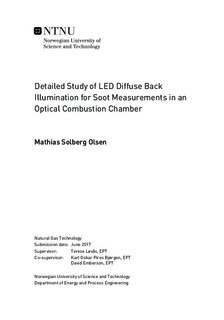Detailed Study of LED Diffuse Back Illumination for Soot Measurements in an Optical Combustion Chamber
Master thesis
Permanent lenke
http://hdl.handle.net/11250/2456114Utgivelsesdato
2017Metadata
Vis full innførselSamlinger
Sammendrag
An optical accessible compression ignition engine is under development at the engine suite at EPT, NTNU. The purpose of the new optical engine is to measure soot formation during the combustion process. In the search of alternative fuels for compression ignition engines, understanding and quantifying soot formation is an essential factor. The current simulation models available for soot formation are lacking in accuracy, especially for now high quality experimental data is still required quantify and properly understand soot formation from alternative fuels. In this project, the goal is to test and investigate the rig and the optical systems ability to detect soot. The soot detection system consists of a high-speed camera and a light source used in a diffused, back-illumination, extinction imaging configuration. In this thesis, a preliminary experiment for soot detection is presented. Together with extensive testing of the engine as a part of the development and finalization of the optical engine rig. To process and analysis images and various sensor data, several MATLAB scripts are purpose written. From the various experiments, settings are suggested to optimize the accuracy of the soot detection method.From the primary soot detection experiment, the KL factor from a soot rich propane flame can be predicted with an uncertainty of ± 4.1% at 2σ confidence interval. With a new optical configuration, the uncertainty in KL factor can possible be further reduced as the conditions for light distortion is reduced. The preliminary soot detection test with a steady state flame shows that the system s ability to detect soot is better or comparable to similar experimental systems.
